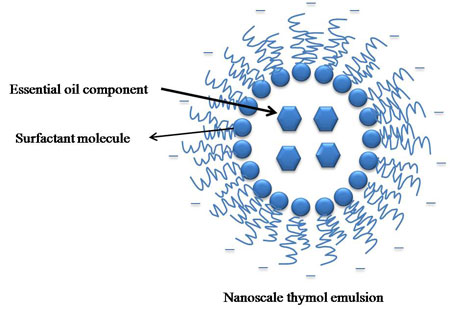| Posted: May 04, 2018 | |
All-natural nanobiotechnology instead of synthetic agrochemicals |
|
| (Nanowerk Spotlight) Widespread use of synthetic agrochemicals in crop protection has led to serious concerns of environmental contamination and increased resistance in plant-based pathogenic microbes. | |
| In an effort to develop bio-based and non-synthetic alternatives, nanobiotechnology researchers are looking to plants that possess natural antimicrobial properties. | |
| Thymol, an essential oil component of thyme, is known for its antimicrobial activity. However, it has low water solubility, which reduces its biological activity and limits its application through aqueous medium. In addition, thymol is physically and chemically unstable in the presence of oxygen, light and temperature, which drastically reduces its effectiveness. | |
| Commercially available thymol formulations have a high concentration of synthetic surfactants. These surfactants are of no use in the target application and make the formulation synthetic in nature. Sometimes this impairs the activity of active compounds and can lead to toxic effects when they enter the food chain. | |
| Scientists in India have overcome these obstacles by preparing thymol nanoemulsions where thymol is converted into nanoscale droplets using a plant-based surfactant known as saponin (a glycoside of the Quillaja tree). Due to this encapsulation, thymol becomes physically and chemically stable in the aqueous medium (the emulsion remained stable for three months). | |
| In their work, the researchers show that nanoscale thymol's antibacterial and antifungal properties not only prevent plant disease but that it also enhances plant growth. | |
 |
|
| Model of thymol nanoemulsion. (Image: Dr. Vinod Saharan, Maharana Pratap University of Agriculture and Technology) | |
| "Normally, emulsions are prepared with synthetic surfactants where the amount of surfactant used is 2-3 times that of the water-immiscible active compound," Dr. Vinod Saharan from the Nano Research Facility Lab, Department of Molecular Biology and Biotechnology, at Maharana Pratap University of Agriculture and Technology, tells Nanowerk. "We have developed our thymol nanoemulsion by using a much lower concentration of saponin as a surfactant." | |
| The researchers have reported their findings in Scientific Reports ("Thymol nanoemulsion exhibits potential antibacterial activity against bacterial pustule disease and growth promotory effect on soybean"). | |
| "It is exciting how nanoscale thymol is more active," says Saharan, who led this work in collaboration with Washington University in St. Louis and Haryana Agricultural University, Hisar. "We found that nanoscale droplets of thymol can easily pass through the surfaces of bacteria, fungi and plants and exhibit much faster and strong activity. In addition nanodroplets of thymol have a larger surface area, i.e. more molecules on the surface, so thymol becomes more active at the target sites." | |
| The thymol nanoemulsion developed by the team is an eco-friendly, biodegradable formulation that is safe for ecosystems and can be a potential alternative for synthetic agrochemicals (antibacterial, fungicide plant growth regulator etc) for food crops. | |
| The team's next steps will be to investigate how other micronutrients and bioactive compounds can be blended with the nanoscale thymol emulsions. | |
| "Thymol nanoemulsion has application in food and agriculture sector as a environment safe anti-bacterial and antifungal agent," Saharan concludes. "Beside this, it also acts as plant growth regulator and further can be exploited as food preservative and use to prevent post harvest losses in agriculture." | |
 By
Michael
Berger
– Michael is author of three books by the Royal Society of Chemistry:
Nano-Society: Pushing the Boundaries of Technology,
Nanotechnology: The Future is Tiny, and
Nanoengineering: The Skills and Tools Making Technology Invisible
Copyright ©
Nanowerk LLC
By
Michael
Berger
– Michael is author of three books by the Royal Society of Chemistry:
Nano-Society: Pushing the Boundaries of Technology,
Nanotechnology: The Future is Tiny, and
Nanoengineering: The Skills and Tools Making Technology Invisible
Copyright ©
Nanowerk LLC
|
|
|
Become a Spotlight guest author! Join our large and growing group of guest contributors. Have you just published a scientific paper or have other exciting developments to share with the nanotechnology community? Here is how to publish on nanowerk.com. |
|
